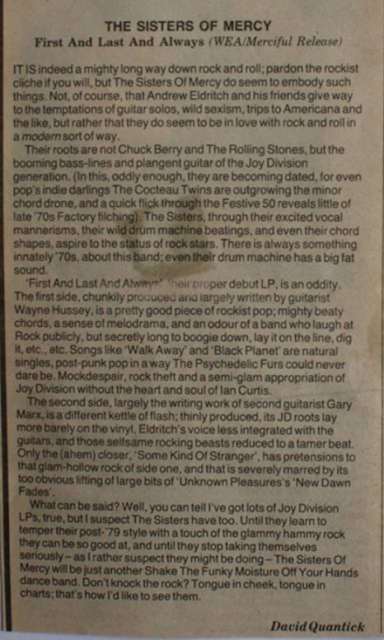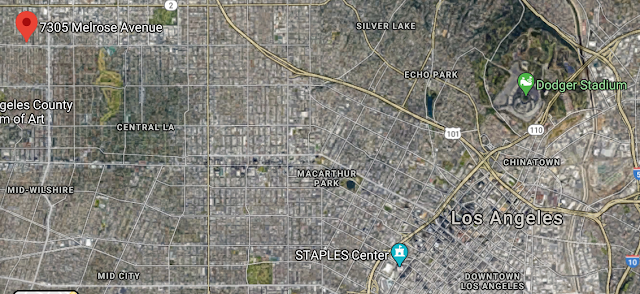This year famously sees the fortieth anniversary of the
release of the debut single by The Sisters of Mercy, The Damage Done/Watch/Home
Of The Hit-Men, on their own Merciful Release label. This is an incredible
milestone, meaning that the band’s first release is as distant in time from us now
in 2020 as the beginning of World War Two and the Battle of Britain were at the
time it came out. Andrew Eldritch always stated that he was embarrassed by this
initial vinyl outing, effectively saying in interviews that it was pretty much
a different band, that TSOM proper didn’t really start until Craig joined and
the band began live performances and that he even wished that they had changed
the band’s name at that stage so that the first single would not be part of
their legacy.
Ultimately Eldritch has softened his view, not only allowing
the debut to feature on the Some Girls Wander By Mistake compilation of
pre-WEA singles and EPs released in 1992 (albeit towards the end of the album
which is in vague chronological order of release but for the fact that it
starts with the third – and breakthrough – single Alice), allegedly to
prevent fans from having to pay astronomical prices to be able to buy a copy, but also posting a highly informative piece
entitled The Making Of The First Single on the band’s own official website.
Eldritch’s account – which, it is assumed, readers of this blog
are familiar with, this post being therefore intended to be complementary to it
- focuses on the motivations and method of himself and Gary Marx as they made
their first stab at fame, revealing that their main aim was to hear themselves
on the radio (a fact we have now proven in a recent post) and spread word of
mouth fame with sales of the band’s iconic t-shirt featuring the Merciful
Release head-and-star logo.
In his inimitable style, Eldritch (assuming that it is him writing in the third person for effect) recounts how “our intrepid
sonic explorers booked themselves half a day's studio time at Ric-Rac Studios,
which was (and possibly still is) a shed in Wortley.” The studio does indeed
still exist all these years after Eldritch penned that account, and is still in
the same unlikely location, surrounded by houses as can be seen in this
screengrab from Google maps and not exactly “the run-down industrial area” the
singer describes.
Eldritch went on to describe the studio owner and his
influence on the finished product – “the only one who knew how to operate the
studio, so he did the engineering. With a beard. Our heroes found it difficult
to convey to him what a non-cabaret act might sound like.” The latter is
probably a reference to comedy folk ensemble The Grumbleweeds who also recorded
at the studio, which had its own label, Luggage, a pun too obvious for the
likes of Eldritch. Commenting on a post about the studio on The Sisters of Mercy 1980-1985 fan Facebook page, Si Denbigh (of The March Violets) commented
that he recalled that the bearded owner Mick Robson had also engineered a
Smurfs album, which he proudly exhibited on a wall in the studio, whilst Dave
Wolfenden (Expelaires/Red Lorry Yellow Lorry) remembered him telling the late
great Mick Karn (of Japan fame) that “his cat could play bass better” than him!
Adding to the legend of the studio being the place of choice for Leeds
post-punk bands to record, Kevin Lycett added that “He walked into a Mekons
session with his cocktail chinking and said 'I'd rather record a cow farting in
a bath'”, adding that Robson was however “one of nature's true gentlemen.”
Robson went to not only engineer the debut Skeletal Family single Trees but
also release it on the Luggage label, and he was still on the mixing desk for
the follow-up The Night which was also recorded at Ric-Rac although
released on Red Rhino (photo below courtesy of Sisters fan Luca G). Incidentally, TSOM fan Mark H, a friend of Robson’s son,
told fellow Sisters fans that “as late as 84 or 85 there was still a reel to
reel tape of this [The Damage Done] in a cupboard under the stairs.” The
current whereabouts of this tape is unknown.
Although the recording of the debut single was Eldritch’s
first experience of a studio, a point he refers to in the official website
account, what is not clear from the singer’s piece is that Gary Marx had not
only recorded with his previous band Naked Voices the year before, but that their
four track demo had also been recorded at Ric-Rac studios. In the very early
days of The Sisters of Mercy, Gary would in fact have very much been the senior
partner in the emerging duo, a theory given extra credence by the fact that it
was his (real) name Mark Pearman (and address) which appears on the receipt for
the masters and acetate pressing of the single, and of course he also provides
the lead vocal on two of the three tracks, a role he had fulfilled in his
previous band.
Not only did Peel play the single twice on his late night BBC
Radio One show, fulfilling Marx and Eldritch’s original dream, but since the post confirming that fact on this blog it has also emerged (on the wonderful Peel fandom wiki) that Peel played Watch a third time, this time on his
BFBS (British Forces Broadcasting Service) show aimed at members of the UK
armed forces and their families stationed overseas (primarily at the very large
British Army bases on the Rhine in what was then West Germany). On Thursday 13th
November 1980, just before the title track from the then new Bauhaus debut LP,
Peel plays the “Marx” side of the single and bemoans the fact that the labels
were on the wrong side, as he did on the second of the two occasions on which
he played the single on his BBC show.
Print reviews of the single would have been very much a
bonus for the band, and Sisters fan Ade M recently unearthed a copy of the
first local review of the band which was published in Leeds Student
newspaper on Friday 14th November 1980. On the same page as live
reviews of Darts, The Jam and Teardrop Explodes (the latter, incidentally, a
gig hosted by John F Keenan’s F Club), the unnamed journalist describes The
Damage Done as “a local band’s single. [It] sounds rather like one man
trying hard to be Bowie. Musically it’s rather simplistic, especially the drums
[!! – the mystery reviewer really seems to have it in for Eldritch!],
which have one tempo that doesn’t match the singing at all, which is ironic as
the singer is asking to be told the rhythm of the dance. Despite this
though, it’s not all that bad.”
It was speculated that this might be the first ever review
the band had received, but research by Phil Verne, the Admin of the 1980-1985
Facebook fan group reveals that the previous week Sounds had also
published a critique of the single (in the edition dated 8th
November 1980), courtesy of then well-known music journalist Robbi Millar, who
was famous at the time for her writings on the emerging New Wave of British
Heavy Metal. If the Leeds Student review was largely negative, it was
positively fawning compared to Millar’s damning verdict. “Merciful this isn’t.
I sometimes wonder if Ian Curtis knew what he was letting the world in for when
he died for us. Certainly, the Joy Division circus hasn’t left us yet and its
impressions grow increasingly gloomy by the day.”
Although many unsold copies of the first single were damaged
in a cellar flood in the early 1980’s (not an unusual occurrence in York, where
Red Rhino was based, and a fact recently confirmed by TSOM fan Jez d’N who
worked at the store), Eldritch claims
that “initially, Red Rhino sold almost enough copies to cover
the manufacturing costs”, and this may or may not include those copies sold at
a later date with a paper insert containing details of the band’s then history.
It has been suggested that this re-release was around the time of Alice,
but the lack of mention of any second guitarist (admittedly a common feature of
the band’s official biographies) and the use of Marx’s contact details might
date this artefact to the previous year, perhaps around the time of the more
favourable word-of-mouth praise that was beginning to circulate around the time
of the Futurama appearance in September 1981.
Either way, both Eldritch and most fans agree that the
making of the first single in itself was more impressive than the sound of the
end result. Visually, the record remains a stunning artefact for a first effort
and was the template for the band’s subsequent releases. Aurally, however, although
a competent debut, there was little to hint at the power, energy and originality
that would characterise the Sisters’ releases from the second single Body
Electric/Adrenochrome onwards.
My grateful thanks for this post are due to Phil Verne, Luca, Ade
M, Jez d’N, Mark H and all others quoted for sharing their memories of the
circumstances of this special release































